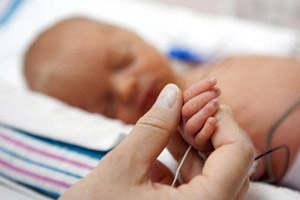Birth injuries may occur to a newborn as a result of a variety of situations and vary in severity depending on the situation, with some resulting in mild or temporary issues and others leading to permanent and even life-threatening problems for the infant. Sometimes issues from a birth injury present themselves immediately. Other times, problems may develop later when a child is older. Because parents typically want to protect their children from harm and injury, it may help to learn about different types of birth defects that could occur.
MUSCLE RELATED
Some birth injuries can result in either muscle rigidity or limpness in an infant. During a traumatic birth, an infant may have an injury as it passes through the birth canal. Breech deliveries can also result in injury to the baby’s arms during a feet-first delivery. Breech deliveries can also lead to the types of birth defects in the sternocleidomastoid muscle. Physical therapy or surgery may be necessary to relieve symptoms. Physicians can offer protection from many muscle related birth injuries by performing Cesarean sections under certain conditions, such as a breech presentation.
- Infant Muscle Rigidity or Stiffness
- Birth Injury
- Birth Injury to the Sternocleidomastoid Muscle
- Congenital Muscular Torticollis
- Congenital Torticollis – Topic Overview
HEAD AND BRAIN RELATED
Injuries to the head and brain are common birth injuries. Some injuries are minor, disappearing with little intervention within a short time. For example, caput succedaneum involves swelling and bruising of a baby’s scalp after moving through the birth canal. This issue typically goes away within a few days without treatment. Subconjunctival hemorrhage involves the small blood vessels of the eyes. Redness in a newborn’s eyes is common after birth, but this issue typically disappears within about 10 days after birth.
Severe head and brain issues can also occur from birth injuries. For example, a prolonged birth with the baby spending a long time in the birth canal could lead to a serious form of cephalohematoma. With cephalohematoma, bleeding occurs between the skull and the membrane beneath the skin. Cephalohematoma can be mild, disappearing without intervention; however, it can also be a symptom of a skull fracture or a head trauma. Babies with cephalohematoma need careful monitoring to protect them from serious health issues.
- Why Brain Injuries Are More Common In Preemies
- What is Brain Injury, Birth Injury and Brain Malformation?
- Birth Injury FAQs
- Cephalohematoma Birth Injuries
- Parturitional Brain Injury
INJURIES CAUSED FROM DELIVERY
Birth defects caused from delivery fall into three main categories. Babies may experience reduced oxygen levels during labor and delivery, resulting in brain damage. Labor and delivery can also result in significant trauma for a baby. This trauma may cause injuries such as brain bleeds and bruising, damage to blood vessels or brain tissue, skull fractions, and brain compression. Vacuum extraction and forceps delivery methods are delivery procedures with a significant link to trauma injuries. During long and difficult labors, babies may also experience issues with a drop in glucose levels. In some cases, this drop can be serious enough to result in a brain injury.
- Labor and Delivery Causes
- Brain Injury in Newborns Could Have Many Causes
- Delivery Issues that cause Cerebral Palsy
NERVE RELATED
Birth injuries may involve damage to nerves. For example, brachial plexus injuries involve weakness or loss of function of an arm, resulting from an injury to nerves in the shoulder area. The severity of this injury can vary, and most babies recover within several months with physical therapy. During a birth using forceps, a baby may receive injury to facial nerves. Injury to facial nerves can also occur if a baby’s face is positioned against the mother’s pelvis in a certain way. The weakness and asymmetrical facial features usually resolve without treatment within two to three months.
- Erb’s Palsy (Brachial Plexus Birth Palsy)
- Brachial Plexus Injury (BPI)
- Brachial Plexus Disorder
- Brachial Plexus Clinic
- Brachial Plexus Injury in Newborns
LACK OF OXYGEN
Lack of oxygen or asphyxia is a common birth injury. If a baby does not receive adequate oxygen before, during, or after birth, serious and permanent damage can occur. Sometimes problems with the placenta occur before or during birth, resulting in asphyxia. Issues with the umbilical cord before or during birth can also cut off a baby’s oxygen supply. A long and traumatic birth could also involve lack of oxygen for a baby, so protection from prolonged labor is important. Health issues resulting from asphyxia include respiratory issues, seizures, brain damage, and reduced kidney function.
Health issues can range in severity, depending on the level and time of asphyxia. Some babies will experience temporary health issues, but can then recover fully within several weeks. Other babies with significant oxygen deprivation could experience significant health problems or even death. Cerebral palsy is one health issue connected with asphyxia. This form of cerebral palsy is known as hypoxic-ischemic encephalopathy, and it occurs when a baby’s brain is damaged from lack of oxygen. Symptoms of this type of cerebral palsy include reduced motor function, delays reaching developmental milestones, and delayed growth. This brain damage is permanent. Children can receive both physical and occupational therapy to treat symptoms.
- What Is Birth Asphyxia?
- Brain and Behavior Problems
- Birth Complications Linked to Autism
- Cooling Treatment for Babies with Perinatal Asphyxia (PDF)
- Common Diagnoses in the NICU
- Developmental Follow-Up of Infants Experiencing Perinatal Asphyxia
- Perinatal Asphyxia
- Cerebral Palsy
- Causes and Risk Factors of Cerebral Palsy
PHARMACEUTICAL DRUG INJURIES
- Types of Birth Defects from Zofran Drug
- Types of Paxil Birth Defects
- Birth Defects from Celexa
- Defects and Disorders from Lexapro
- Top Medications Associated With Birth Defects






